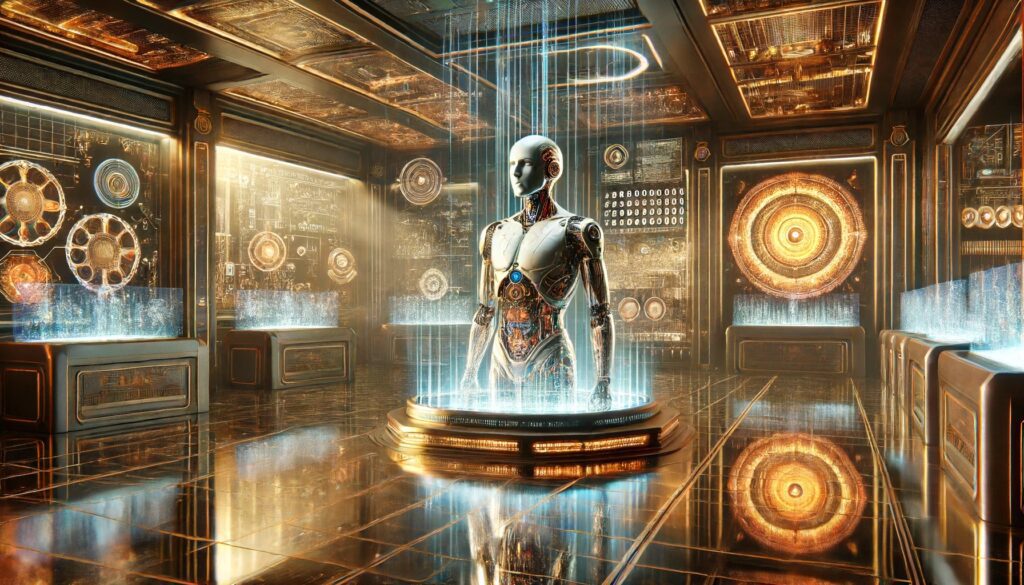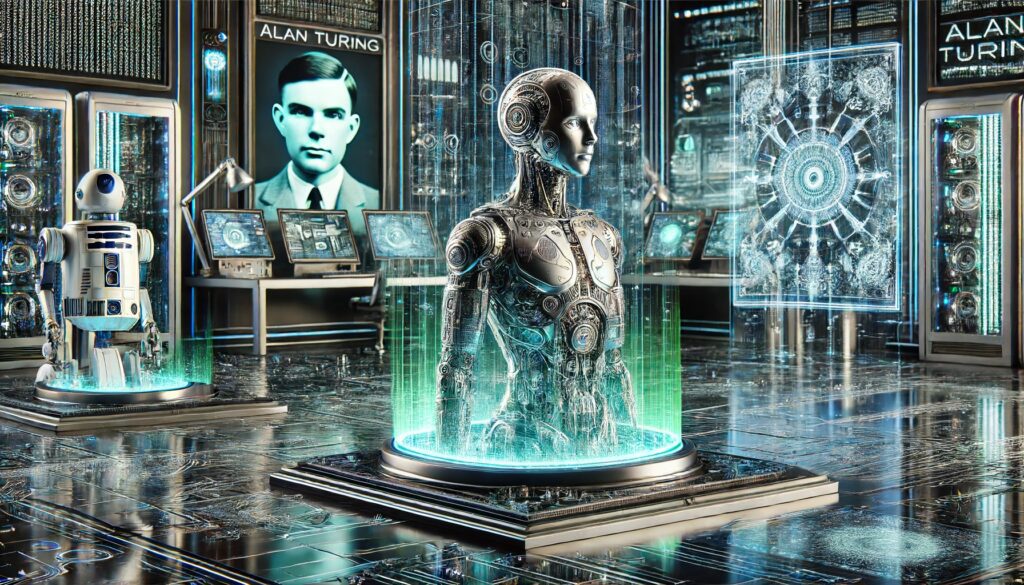
AI Passes Turing Test: Next Steps in Machine Intelligence
Is that really the case..? And what does Turing artificial intelligence mean?
The Visionary Mind of Alan Turing
Alan Turing, often hailed as the father of artificial intelligence and modern computer science, was a mathematician whose groundbreaking ideas laid the foundation for the field of AI. His theoretical work on the Turing machine in 1936 formalized the concepts of computation and algorithms, which are core to today’s computer operations.
Breaking the Enigma: Turing’s War Effort
During World War II, Turing played a crucial role in breaking the Enigma code, which was used by Nazi Germany for secure communication. His work at Bletchley Park not only shortened the war but also showcased the potential of machines to perform complex tasks traditionally thought to be solvable only by humans. This achievement highlighted the practical applications of his earlier theoretical work and solidified his reputation as a computing pioneer.

Midjourney AI, prompted by Netha Hussain, Public domain, via Wikimedia Commons
The Turing Test: A Measure of Machine Intelligence
In 1950, Turing introduced the Turing Test, a criterion for determining whether a machine can exhibit human-like intelligence. The test involves a human evaluator interacting with a machine and a human without knowing which is which; if the evaluator cannot reliably distinguish between the machine and the human, the machine is said to have passed the test. This concept has become a cornerstone in the field of AI, driving research into natural language processing and machine learning.
Legacy and Impact on AI
Turing’s vision extended beyond his lifetime, influencing generations of scientists and researchers. His ideas on machine learning, neural networks, and the potential for computers to simulate any human activity continue to inspire advancements in AI. The ethical considerations he pondered also remain relevant, as today’s AI systems raise questions about bias, transparency, and accountability.
Understanding Alan Turing’s contributions helps us appreciate the profound impact he had on computing and artificial intelligence, shaping the technologies that drive our modern world.

Understanding the Turing AI Test
Definition and Purpose
The Turing Test, named after British mathematician and computer scientist Alan Turing, is a measure of a machine’s ability to exhibit intelligent behavior equivalent to, or indistinguishable from, that of a human. Turing introduced this concept in his 1950 paper, “Computing Machinery and Intelligence,” where he explored the question, “Can machines think?”
How the Turing Test Works
The test involves a human evaluator interacting with both a machine and another human through a computer interface. The evaluator’s task is to determine which of the two respondents is human and which is a machine. If the machine can deceive the evaluator into thinking it is human more often than not, it is considered to have passed the Turing Test.
Significance and Applications
The Turing Test is significant because it provides a practical framework for assessing artificial intelligence. It focuses on the machine’s ability to use natural language, reason, learn, and exhibit knowledge—key aspects of human intelligence. While the test has its limitations and critics, it remains a fundamental concept in AI research and development.
Advancements and Modern Perspectives
Recent advancements in AI, particularly with large language models like GPT-4, have pushed the boundaries of what machines can achieve. These models have demonstrated the ability to engage in complex conversations and perform tasks that are increasingly human-like. However, the Turing Test also highlights ongoing debates about the nature of intelligence, consciousness, and the ethical implications of AI.
Key Elements of the Turing AI Test
- Human Evaluator: A person who interacts with both the machine and another human.
- Machine and Human Respondents: The machine attempts to mimic human responses, while the human provides genuine answers.
- Interaction Medium: Typically, the interactions occur via text to avoid biases based on voice or appearance.
Criticisms and Limitations
- Behavior vs. Understanding: Critics argue that passing the Turing Test only demonstrates the machine’s ability to mimic human behavior, not true understanding or consciousness.
- Test Conditions: The conditions under which the test is conducted can affect outcomes, including the complexity of questions and the skill of the evaluator.
- Ethical Considerations: There are concerns about the ethical implications of machines that can convincingly mimic humans, including issues of trust and transparency.
Conclusion
The Turing Test remains a foundational concept in artificial intelligence, challenging researchers to develop machines that can emulate human intelligence. As AI continues to evolve, the test serves as a benchmark for progress while also prompting important discussions about the future of human-machine interaction.

AI Passes Turing Test: Next Steps in Machine Intelligence
Understanding the Claims
Recently, there have been claims that advanced AI systems like ChatGPT have passed the Turing Test, a benchmark designed to evaluate a machine’s ability to exhibit human-like intelligence. If the judge cannot reliably distinguish the machine from the human, the machine is said to have passed the test.
Mixed Results from Recent Evaluations
Stanford Study: A study by Stanford researchers found that the latest version of ChatGPT, specifically version 4, performed exceptionally well in behavioral tests, often indistinguishable from human counterparts. This version demonstrated human-like cooperation and altruism, contributing to its success in passing a rigorous Turing Test setup. However, it was noted that while ChatGPT could mimic human-like behavior, it did not inherently possess understanding or consciousness.
Nature’s Perspective: Another perspective highlights the limitations of the Turing Test itself. While ChatGPT can convincingly mimic human conversation, critics argue that this does not equate to true understanding or reasoning. The test measures surface-level interactions rather than deeper cognitive processes, which are crucial for genuine intelligence.
TechRadar’s Insights: TechRadar also reported that ChatGPT has crossed the threshold of the Turing Test in many everyday use cases. However, the rapid development and integration of such technology raise concerns about ethical implications, data privacy, and the potential for misuse.
Limitations and Criticisms
Despite these achievements, there are significant limitations to consider:
- Repetitive Patterns: ChatGPT can sometimes produce repetitive or patterned responses, which can reveal its artificial nature.
- Contextual Misunderstandings: The AI may misunderstand or misinterpret complex or nuanced questions, leading to irrelevant or inaccurate responses.
- Lack of Personal Experience: ChatGPT lacks personal experiences and emotions, making it difficult to provide authentic responses to questions requiring these elements.
These limitations suggest that while ChatGPT has made significant strides, it may not fully meet the rigorous standards of the Turing Test under all conditions.

The Latest in Turing Artificial Intelligence: Breaking New Ground
Pushing the Boundaries of the Turing Test
The Turing Test remains a pivotal benchmark for evaluating machine intelligence. Recent advances in large language models (LLMs) like GPT-4 have allowed AI to pass rigorous Turing tests, convincingly mimicking human conversation. Researchers at Stanford have demonstrated that ChatGPT can exhibit behaviors closely aligned with human traits, pushing the envelope of what AI can achieve.
AI Ethics: Ensuring Fair and Moral AI
As AI systems become more integrated into our daily lives, ethical considerations have never been more critical. Ensuring AI ethics and unbiased decision-making are at the forefront of current AI development. Efforts are focused on embedding moral frameworks within AI to promote fairness and transparency, designing AI systems that adhere to ethical guidelines, minimizing biases, and incorporating robust fail-safes to prevent unethical outcomes.
Advanced Machine Learning: Mimicking the Human Brain
The rapid evolution of machine learning, especially deep learning and neural networks, is enabling AI to emulate the complexity of the human brain. Reinforcement learning techniques are being utilized to develop AI that can learn and adapt from interactions, improving over time. Additionally, transfer learning is enhancing AI’s ability to apply knowledge across different domains, making it more versatile and intelligent.
AI in Daily Life: Transforming Our Homes and Workplaces
From smart homes to autonomous vehicles, AI is increasingly present in our daily lives. Virtual assistants powered by AI are becoming more sophisticated, offering personalized assistance and improving our interaction with technology. In healthcare, AI is revolutionizing diagnostics and patient care, providing precise treatment recommendations and monitoring patient health in real-time.
AI and Creativity: Co-Creating the Future
AI’s role in creative fields is expanding, with AI-generated art, music, and literature gaining recognition. Collaborative efforts between humans and AI are fostering new forms of creativity, leading to innovative artistic expressions. This synergy not only enhances artistic outputs but also pushes the boundaries of what is considered creative, challenging traditional notions.
AI in Business: Driving Efficiency and Innovation
Businesses are leveraging AI to enhance decision-making, predict market trends, and optimize operations. AI-driven predictive analytics are providing deeper insights into consumer behavior and market dynamics, enabling companies to stay ahead of the curve. In supply chain management, AI is improving efficiency and reducing costs by optimizing logistics and operations.
AI Safety and Security: Protecting Our Future
The rise of AI brings with it concerns about security and privacy. Developing robust cybersecurity measures to protect against AI-driven threats is essential. Ensuring that AI systems comply with data privacy regulations is crucial for maintaining trust and protecting user information. Addressing these challenges involves continuous innovation and vigilance.
AI and Human Interaction: Enhancing Connections
Improving human-computer interaction through advanced natural language processing is making AI more intuitive and user-friendly. Emotional AI is being developed to provide support in mental health, offering empathetic and personalized assistance. AI companions are also being explored as a means to combat loneliness and social isolation, providing companionship and support to those in need.
Future of AI: Looking Ahead
The future of AI holds immense potential, with advancements likely to transform every aspect of our lives. Predictions suggest that AI could achieve superintelligence, raising questions about its implications for society. Long-term goals include developing AI that can think and learn autonomously, paving the way for new innovations and possibilities.
Update: July 2024
GPT-4 Passes Turing Test: What It Means for AI’s Future
Introduction In a recent study by UC San Diego, GPT-4 demonstrated its advanced capabilities by passing the Turing Test. This milestone highlights the rapid progress in AI’s ability to mimic human conversation.
Study Highlights Researchers conducted a five-minute text-based conversation test where participants interacted with either a human or an AI model (ELIZA, GPT-3.5, or GPT-4). Participants then judged if they believed they were speaking to a human. Impressively, 54% of participants mistook GPT-4 for a human, compared to 22% for ELIZA and 50% for GPT-3.5.
Key Findings Participants often relied on linguistic style, socio-emotional cues, and knowledge-based responses to make their judgments. Despite various strategies, distinguishing between human and AI remains challenging. This shows that stylistic and socio-emotional factors are crucial in passing the Turing Test, rather than just traditional measures of intelligence.
Implications for Human-AI Interaction This development suggests significant potential for AI in areas requiring natural language understanding, like customer service and virtual assistance. However, it also raises ethical concerns about AI deception and the need for transparency in AI-human interactions.
Conclusion The ability of GPT-4 to convincingly mimic human conversation marks a significant step forward in AI development. As AI continues to evolve, it is crucial to address the ethical implications and ensure responsible use of this technology.
For more details, visit the full studies:
Understanding the advancements in Turing artificial intelligence helps us prepare for its profound impact on society, driving both opportunities and challenges in the coming years.
References:
- Stanford School of Humanities and Sciences
- Nature
- TechRadar
- AI Mode
- NVIDIA Newsroom
- A.I. News Briefing
People Also Ask (PAA) About AI and the Turing Test
What is the Turing Test in AI?
The Turing Test is a benchmark for determining whether a machine can exhibit human-like intelligence. Proposed by Alan Turing in 1950, it involves a human judge engaging in a conversation with both a machine and another human. If the judge cannot reliably tell the machine from the human based on their responses, the machine is considered to have passed the test.
Has any AI passed the Turing Test?
There have been claims that some advanced AI systems, such as GPT-4, have passed versions of the Turing Test. For example, a Stanford study found that the latest version of ChatGPT performed exceptionally well in behavioral tests, often indistinguishable from human counterparts. However, there are ongoing debates about whether passing the Turing Test truly signifies human-like understanding or just sophisticated mimicry (humsci.stanford).
What are the limitations of the Turing Test?
The Turing Test has several limitations:
- Surface-Level Interaction: It measures only the ability to mimic human conversation, not true understanding or consciousness.
- Repetitive Patterns: AI can produce repetitive or patterned responses that reveal its artificial nature.
- Contextual Misunderstandings: AI may struggle with complex or nuanced questions.
- Lack of Personal Experience: AI lacks personal experiences and emotions, which can affect the authenticity of its responses.
Why is the Turing Test important?
The Turing Test remains a significant milestone in AI development as it challenges researchers to create machines that can convincingly mimic human intelligence. It also raises important questions about the nature of intelligence, consciousness, and the ethical implications of advanced AI systems (nature) (TechRadar).
How does the Turing Test work?
In the Turing Test, a human judge interacts with both a machine and a human through a text-based interface. The judge must determine which respondent is human and which is the machine. If the machine’s responses are indistinguishable from the human’s, it is considered to have passed the test (humsci.stanford) (Aimode).
What are the criticisms of the Turing Test?
Critics argue that the Turing Test:
- Focuses on superficial conversational ability rather than genuine understanding.
- Does not account for the vast differences between human and machine cognition.
- Can be passed by AI systems using sophisticated pattern recognition without true intelligence.
- Neuro-Symbolic Integration
- Interpretability and Explainability in Machine Learning